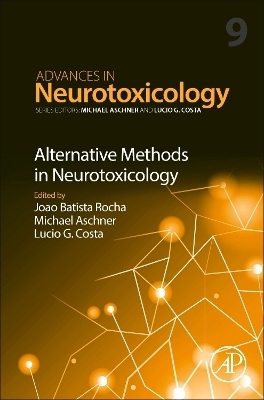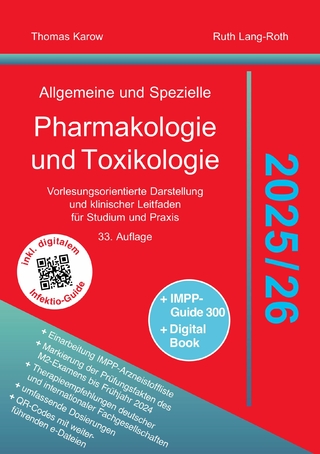
Alternative Methods in Neurotoxicology
Academic Press Inc (Verlag)
978-0-443-18582-3 (ISBN)
Other chapters cover Human Neural Stem Cells in Developmental Neurotoxicology: Current Scenario and Future Prospects, Use of Drosophila melanogaster for advances in developmental neurotoxicology studies, 3D neurospheres and neurotoxicity of organophosphorus and TCE, Genetic factors in methylmercury-induced neurotoxicity: what we have learned from Caenorhabditis elegans models, and more.
Dr. Rocha serves as full professor of toxicological biochemistry at the Departament of Biochemistry and Molecular Biology in the Center of Natural and Exact Sciences, FederaL University of Rio Grande do Sul, Brazil. He researches areas include the use of alternative invertebrate models in neurotoxicology and the interaction of mercury forms with the selenol group of selenoproteins and low-molecular mass selenium-containing molecules One important subtopic focused in the interaction of methylmercury and Hg2+ with thiol- and selenol-containing molecules both in silico and in vitro. The main aims of in vitro studies are to determine how mercury disrupt the thiol- and selenol-containing proteins in the nervous system of invertebrates. The in silico studies aims are to develop chemical and biochemical models to predict how electrophilic mercury forms can disrupt the function of thiol- and selenol-containing proteins. Specially, on how the interaction of Hg forms can impair the cell redox environment by inactivating or sequestering the trace element selenium. He has authored (co-authored) >500 peer reviewed manuscripts and 20 book chapter and is associated editor of Neurotoxicology and the Journal of Animal Physiology and Animal Nutrition. Dr. Aschner serves as the Harold and Muriel Block Chair in Molecular Pharmacology at Albert Einstein College of Medicine. He served on numerous toxicology panels (Institute of Medicine, US Environmental Protection Agency, Center for Disease Control), and is a member of the Neurotoxicology and Alcohol study section (NIH). Research in our lab focuses on the following topics: (1) Modulation of C. elegans genes (aat, skn-1, daf-16) that are homologous to mammalian regulators of MeHg uptake and cellular resistance will modify dopaminergic neurodegeneration in response to MeHg exposure. (2) Under conditions of MeHg-induced oxidative stress, Nrf2 (a master regulator of antioxidant responses) coordinates the upregulation of cytoprotective genes that combat MeHg-induced oxidative injury, and that genetic and biochemical changes that negatively impact upon Nrf2 function increase MeHg’s neurotoxicity. (3) PARK2, a strong PD genetic risk factor, alters neuronal vulnerability to modifiers of cellular Mn status, particularly at the level of mitochondrial dysfunction and oxidative stress. Our studies are designed to (1) shed novel mechanistic insight into metal-induced neurodegeneration; (2) identify targets for genetic or pharmacologic modulation of neurodegenerative disorders; (3) increase knowledge of the pathway involved in oxidative stress; (4) develop improved research models for human disease using knowledge of environmental sciences. Dr. Lucio G. Costa is Professor of Toxicology at the University of Washington in Seattle, and of Pharmacology/Toxicology at the University of Parma Medical School. He received a doctorate in Pharmacology from the University of Milano in 1977, and was a postdoctoral fellow at the University of Texas at Houston. He is a member of several national and international professional organizations, a Fellow of the Academy of Toxicological Sciences, and a European Certified Toxicologist. He received various award for his scientific accomplishments, including the Achievement Award from the Society of Toxicology. He serves in various editorial capacities for several toxicology journals, and is an active manuscript and grant reviewer. Dr. Costa has been the member of dozens of panels and committees at the national and international level dealing with toxicology and risk assessment issues. He has chaired and/or organized symposia at scientific meetings in the United States and internationally. He has been teaching classes in the area of toxicology, neurotoxicology and pharmacology to graduate and medical students for 30 years. He keeps an active research program in the area of neurotoxicology.
Preface
Joao Batista Rocha, Michael Aschner and Lucio G. Costa
1. Assessment of mitochondrial function in neurotoxicology using alternative model organisms
Gonçalves, D.F., Michelotti, P, da Silva A.F., Soares, F.A.A. and Dalla Corte, C.L.
2. Planarians as a model to study neurotoxic agents
Danielle Ireland and Eva-Maria S. Collins
3. The role of Drosophila melanogaster in neurotoxicology studies: Responses to different harmful substances
Mustafa Munir Mustafa Dahleh and Marina Prigol
4. Neurotoxicology of metals and metallic nanoparticles in Caenorhabditis elegans
Danielle Araujo Agarrayua, Aline Castro Silva, Nariani Rocha Saraiva, Ana Thalita Soares, Michael Aschner and Daiana Silva Ávila
5. Neurotoxicology of organic environmental toxicants using Caenorhabditis elegans as a model
Marcell Valandro Soares, Gabriel Pedroso Viçozzi, Eugenia Carla Kuhn, Ann-Kathrin Weishaupt, Laura Kubens, Julia Bornhorst and Daiana Silva Avila
6. Nauphoeta cinerea as an emerging model in neurotoxicology
Isaac A. Adedara, Khadija A. Mohammed, Julia Canzian, Denis B. Rosemberg, Michael Aschner, Ebenezer O. Farombi and Joao B. T. Rocha
7. Human neural stem cells in developmental neurotoxicology: Current scenario and future prospects
Andreea Rosca, Raquel Coronel, Victoria Lopez, Isabel Liste and M. Carmen González-Caballero
8. Perspectives for advancing neurotoxicity studies with Drosophila
Catherine R. Beamish, Adwitia Dey, Souvarish Sarkar and Matthew D. Rand
9. Genetic factors in methylmercury-induced neurotoxicity: What have we learned from Caenorhabditis elegans models?
Tao Ke, Fernando Barbosa Junior, Abel Santamaria, Aaron B. Bowman and Michael Aschner
10. Usefulness of Drosophila in studying Parkinson’s disease and role of natural plant products
Himanshi Varshney and Yasir Hasan Siddique
11. Neurotoxicity of iron (Fe) in Drosophila and the protective roles of natural products
Kehinde D. Fasae, Olugbenga Adeyemi, Hameed O. Faleke and Amos O. Abolaji
| Erscheinungsdatum | 10.07.2023 |
|---|---|
| Reihe/Serie | Advances in Neurotoxicology |
| Verlagsort | San Diego |
| Sprache | englisch |
| Maße | 152 x 229 mm |
| Gewicht | 450 g |
| Themenwelt | Medizin / Pharmazie ► Medizinische Fachgebiete ► Neurologie |
| Studium ► 2. Studienabschnitt (Klinik) ► Pharmakologie / Toxikologie | |
| Naturwissenschaften ► Biologie ► Biochemie | |
| Naturwissenschaften ► Biologie ► Humanbiologie | |
| Naturwissenschaften ► Biologie ► Zoologie | |
| ISBN-10 | 0-443-18582-4 / 0443185824 |
| ISBN-13 | 978-0-443-18582-3 / 9780443185823 |
| Zustand | Neuware |
| Informationen gemäß Produktsicherheitsverordnung (GPSR) | |
| Haben Sie eine Frage zum Produkt? |
aus dem Bereich


